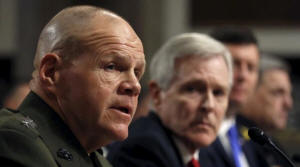|
Top U.S. Marine's wish-list for Trump
goes well beyond troop hikes
 Send a link to a friend
Send a link to a friend
 [December 06, 2016]
By Phil Stewart [December 06, 2016]
By Phil Stewart
WASHINGTON (Reuters) - U.S. Marine Corps
Commandant General Robert Neller, like much of the Pentagon top brass,
is pretty happy about President-elect Donald Trump's campaign pledge to
rebuild America's military after years of congressionally imposed
spending caps.
But ask Neller about Trump's main proposal to increase the number of
Marine infantry battalions from 24 today to 36, and he pauses.
"That's a lot," Neller told Reuters in an interview.
Neller, like many of his Pentagon colleagues, thinks America's military
needs to shift quickly to prepare for more sophisticated adversaries
than the insurgents the United States has been fighting in Iraq, Syria
and Afghanistan.
That will require more troops, including in the infantry. But Neller
wants more cyber, intelligence and avionics specialists, as well as
additional jets, amphibious ships and other weaponry that can better
prepare the Marine Corps for a potential conflict with another country.
Islamic extremists are certainly lethal, Neller says, but are not nearly
as capable as even the Russia-backed separatists that Ukraine is
fighting, whose arsenal includes drones, radar and accurate artillery,
for example.

"If you think the next war's going to be like this (counter-insurgency
battle), then OK fine. I don't think it is. I don't," Neller said.
"It's going to be much more difficult. It's going to be much more
complicated. It's going to be much more sophisticated."
At the Reagan National Defense Forum in California, Neller said his
wish-list for the Marine Corps included speeding up purchases of
higher-end items, including Lockheed Martin Corp's stealth supersonic
F-35 aircraft and the Joint Light Tactical Vehicle (JLTV) made by
Oshkosh Corp.
Trump's campaign proposal for the Marine Corps was based on a Heritage
Foundation study that determined that 36 active-duty battalions would be
necessary to wage two wars at once.
"Having this ability deters other competitors from trying to take
advantage of the U.S. being 'tied down' in a conflict in one region,"
wrote the Heritage Foundation's Dakota Wood.
To that end, Trump has also pledged to build an active Army of around
540,000, up from about 475,000 today and build a Navy approaching 350
surface ships and submarines, up from just over 290 ships today. He
pledged to give the Air Force at least 1,200 fighter aircraft, about 100
more than today.
Air Force Secretary Deborah Lee James, speaking at the same defense
forum, welcomed the possibility of more aircraft and, like Neller,
expressed interest in accelerating the acquisition of F-35 aircraft.
"Additional aircraft would certainly allow us to be able to do different
jobs across the word simultaneously," James said, also noting the need
for a new bomber.
[to top of second column] |

Commandant of the U.S. Marine Corps Gen. Robert Neller (L) testifies
during a Senate Armed Services Committee hearing on the
implementation of the decision to open all ground combat units to
women on Capitol Hill in Washington, February 2, 2016. REUTERS/Kevin
Lamarque

But James also spoke of other high-end capabilities, including in
space, and warned about the need for Congress to fund nuclear
modernization, which some estimates say will cost about $1 trillion
over the next three decades.
Chief of Naval Operations Admiral John Richardson said the U.S. arms
industry is ready and capable of boosting production of new ships to
meet Trump's campaign pledge.
Shifting the current target of 308 ships upwards would be
"remarkably easy," as long as there is funding to pay the bill.
"If it's resourced, it's a matter of working closely with the
industrial base, and they definitely are ready to do that," he told
Reuters, adding the only limiting factor would be hiring and
training workers to build the new ships.
Republicans, who will control both houses of Congress and the White
House after Trump is sworn in on Jan. 20, see good prospects for
raising military spending levels and scrapping a 2010 law that
imposed mandatory cost caps on defense spending.
Still, it's unclear how Trump will fund all of his planned programs,
which beyond the military spending spree includes paying for a major
U.S. domestic infrastructure program.
For Neller and other Pentagon chiefs, investing to prepare for more
advanced threats is a priority, regardless of whether Trump makes
good on his pledges.

"The only thing we're not going to do is stay the same. We're not.
Can't. I'd be derelict in my duties," Neller said.
(Additional reporting by Andrea Shalal; Reporting by Phil Stewart;
Editing by James Dalgleish)
[© 2016 Thomson Reuters. All rights
reserved.]
Copyright 2016 Reuters. All rights reserved. This material may not be published,
broadcast, rewritten or redistributed. |